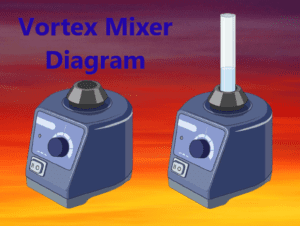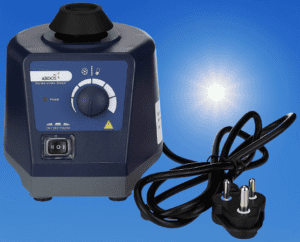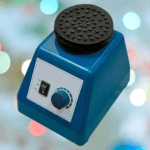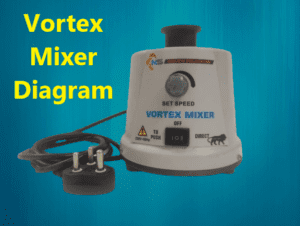The vortex mixer, a remarkable tool found in laboratories across various scientific disciplines, holds a position of significance in the realm of mixing and agitation. This ingenious device harnesses the power of fluid dynamics to create a whirlpool-like motion, facilitating efficient and thorough blending of substances.
At its core, a vortex mixer consists of a motor-driven base and a cylindrical chamber. The chamber contains a rubber cup or foam insert that securely holds the vessels, such as test tubes or microcentrifuge tubes. When activated, the motor spins the cup or insert, generating a vortex within the samples.
vortex mixer principle
The principle behind a vortex mixer lies in the application of fluid dynamics to achieve efficient mixing and agitation. The device utilizes a simple yet effective mechanism to generate a whirlpool-like motion, enabling the thorough blending of substances.

At its core, a vortex mixer consists of a motor-driven base and a cylindrical chamber. The chamber contains a rubber cup or foam insert that securely holds the vessels, such as test tubes or microcentrifuge tubes. When the vortex mixer is activated, the motor spins the cup or insert, creating a circular motion within the samples.
The principle of a vortex mixer is based on the concept of centrifugal force. As the cup or insert rotates, the centrifugal force pushes the liquid or solid components outward from the center of the vessel. This outward movement generates a vortex or swirling pattern within the sample, resulting in mixing and agitation.
The vortex created by the mixer allows for efficient blending of substances by inducing turbulent flow. The swirling motion disrupts the boundaries between different components, facilitating their integration and homogenization. This ensures that the entire sample is exposed to the mixing action, leading to uniform distribution of particles or solutes.
The speed at which the cup or insert rotates can be adjusted to achieve the desired level of mixing intensity. Higher speeds result in more vigorous agitation, while lower speeds provide gentle mixing. This versatility allows users to tailor the vortex mixer’s operation to the specific requirements of different applications.
The principle of a vortex mixer is relatively straightforward, yet its implementation yields significant benefits in laboratory settings. By harnessing fluid dynamics forces, the vortex mixer offers a reliable and efficient solution for achieving uniform mixing and dissolution of substances in various scientific disciplines, such as biology, chemistry, and pharmaceutical research.
In conclusion, the vortex mixer operates on centrifugal force, utilizing a rotating cup or insert to create a swirling vortex within the sample. This motion enables efficient mixing and agitation, leading to the uniform blending of substances. With its simplicity and effectiveness, the vortex mixer serves as a valuable tool in laboratory environments where precise and thorough mixing is crucial.
vortex mixer in microbiology lab
The vortex mixer plays a crucial role in microbiology laboratories, where it serves as an invaluable tool for various applications. With its ability to create a swirling vortex motion, this device aids in sample preparation, microbial cell disruption, and suspension homogenization, among other essential processes.
One of the primary uses of a vortex mixer in microbiology is the homogenization of samples. Microorganisms often form aggregates or settle at the bottom of the container, making it necessary to resuspend them evenly before further analysis or experimentation. The vortex mixer’s whirlpool-like motion effectively disrupts these aggregates and facilitates the creation of homogeneous suspensions. This ensures that the microorganisms are uniformly distributed within the sample, enabling accurate analysis and measurements.
In addition to sample homogenization, the vortex mixer assists in the extraction of intracellular components from microbial cells. Many molecular biology and genetics techniques require the isolation of DNA, RNA, proteins, or other cellular components for further analysis. The vortex mixer’s agitation and disruption capabilities aid in breaking open the microbial cells, allowing for efficient extraction of these biomolecules. This process is crucial for various downstream applications, such as PCR, genetic sequencing, and protein analysis.
Furthermore, the vortex mixer finds utility in the preparation of microbial dilutions. Dilutions are commonly performed in microbiology to obtain viable cell counts or to reduce the concentration of microorganisms for specific experiments. By vortexing the sample in a suitable diluent, the vortex mixer ensures thorough mixing, enabling accurate dilution and subsequent plating or enumeration.
The vortex mixer’s versatility extends beyond microbial samples. In the field of microbiology, it is also utilized for mixing reagents, buffers, and media. By creating a vortex, the mixer facilitates the rapid and uniform dispersion of powders, solutes, or additives into the liquid phase, ensuring consistent composition and avoiding concentration gradients.

In conclusion, the vortex mixer is an indispensable instrument in microbiology laboratories. Its ability to generate a swirling vortex motion enables efficient sample homogenization, microbial cell disruption, and suspension preparation. By utilizing the vortex mixer’s capabilities, microbiologists can achieve uniformity and reliability in sample processing, contributing to accurate analyses and experiments in the field of microbiology.
uses of vortex mixer
| Application | Description |
|---|---|
| Sample Homogenization | Efficiently homogenize samples by disrupting aggregates and ensuring uniform suspension of microorganisms or particles. |
| Cell Disruption | Aid in the extraction of intracellular components such as DNA, RNA, and proteins by breaking open microbial cells through agitation. |
| Suspension Mixing | Facilitate the uniform mixing of reagents, buffers, and media by creating a vortex motion, ensuring consistent composition and avoiding concentration gradients. |
| Dilution Preparation | Assist in the preparation of microbial dilutions, enabling accurate cell counting or reducing the concentration of microorganisms for specific experiments. |
| Enzyme Reactions | Aid in enzyme reactions by providing rapid and uniform mixing of reactants, enhancing reaction efficiency and enabling consistent results. |
| Sample Extraction | Assist in the extraction of compounds from solid samples or extraction phases by providing vigorous mixing to enhance the extraction process. |
| Assay Development | Contribute to the development and optimization of various assays by enabling efficient mixing of assay components, enhancing reaction kinetics and sensitivity. |
| Immunoprecipitation | Facilitate immunoprecipitation protocols by enabling thorough mixing of antibodies and antigens, enhancing antibody-antigen binding efficiency. |
| Cell Culture | Aid in the resuspension of cells and facilitate the thorough mixing of cell culture media, supplements, and antibiotics for consistent and homogeneous cell growth. |
| PCR and Genetic Tests | Assist in the resuspension of DNA, primers, and other reaction components for polymerase chain reaction (PCR) and genetic testing applications, ensuring uniform distribution and reaction efficiency. |
Applications of vortex mixer
| Field | Applications |
|---|---|
| Microbiology | Sample homogenization, cell disruption, suspension mixing, dilution preparation, enzyme reactions, sample extraction, assay development, immunoprecipitation, cell culture, PCR and genetic tests |
| Biochemistry | Protein and enzyme assays, sample mixing and vortexing, cell lysate preparation, reagent and buffer mixing |
| Molecular Biology | DNA and RNA extraction, PCR setup, restriction enzyme digestion, nucleic acid hybridization, sample resuspension, library preparation, genotyping assays |
| Chemistry | Solvent mixing, solution preparation, sample reconstitution, dissolution of compounds, sample extraction, emulsion formation |
| Pharmaceutical Science | Drug dissolution testing, formulation mixing, sample preparation for analysis, blending excipients and active ingredients |
| Food Science | Sample homogenization, mixing additives, emulsion preparation, extraction of food components, reconstitution of powdered samples |
| Environmental Analysis | Sample extraction, reagent mixing, suspension preparation, sample dilution, preparation of calibration standards |
| Forensic Science | DNA extraction, sample mixing, reagent preparation, forensic sample resuspension, extraction of trace substances |
| Quality Control | Sample preparation, blending of samples, mixing standards and controls, uniform dispersion of particles, emulsion stability testing |
| Research and Development | Sample processing, assay development, formulation optimization, reagent preparation, mixing of experimental samples |
Advantages & disadvantages of vortex mixer
| Advantages | Disadvantages |
|---|---|
| Efficient and rapid mixing of samples | Limited capacity for large volumes |
| Simple and easy to use | Lack of temperature control in basic models |
| Versatile and suitable for various applications | Not suitable for delicate or sensitive samples |
| Requires minimal sample handling | Limited control over mixing speed or intensity |
| Provides uniform mixing and homogenization | Possibility of aerosol formation during operation |
| Compatible with a wide range of tube sizes | Relatively higher noise levels during operation |
| Compact and space-saving design | Limited ability to perform timed or programmed mixing |
| Cost-effective compared to other mixing methods | May not be suitable for specialized applications |
Frequently Asked Questions:
What is a vortex mixer?
Answer: A vortex mixer is a laboratory instrument that creates a swirling vortex motion to facilitate mixing and agitation of samples.
How does a vortex mixer work?
Answer: A vortex mixer works by using a motor-driven base to rotate a rubber cup or foam insert, creating a vortex motion within the sample.

What is the purpose of using a vortex mixer in a microbiology lab?
Answer: The purpose of using a vortex mixer in a microbiology lab is to homogenize samples, disrupt microbial cells, and facilitate suspension mixing.
What are the applications of a vortex mixer in microbiology?
Answer: Some applications of a vortex mixer in microbiology include sample homogenization, cell disruption, dilution preparation, and DNA extraction.
How does a vortex mixer assist in sample homogenization?
Answer: A vortex mixr disrupts aggregates and ensures uniform suspension of microorganisms or particles, resulting in sample homogenization.
What is the maximum sample volume that can be accommodated by a vortex mixer?
Answer: The maximum sample volume that can be accommodated depends on the specific model and design of the vortex mixr, but it is typically in the range of a few milliliters to several milliliters.
Can a vortex mixer handle different tube sizes?
Answer: Yes, many vortex mixrs come with interchangeable inserts or adapters that can accommodate various tube sizes, such as test tubes or microcentrifuge tubes.
Does a vortex mixer provide temperature control during mixing?
Answer: Basic models of vortex mixrs typically do not provide temperature control. However, there are advanced models available that offer temperature control features.
What safety precautions should be taken when using a vortex mixer?
Answer: Safety precautions include wearing appropriate personal protective equipment, ensuring proper stability of the mixer, and avoiding overfilling the sample containers to prevent spills.
Can a vortex mixer be used with delicate or sensitive samples?
Answer: It is important to consider the sensitivity of the samples. Vortex mixing may not be suitable for very delicate or sensitive samples that may be affected by vigorous agitation.
Is it possible to control the mixing speed or intensity on a vortex mixer?
Answer: Basic models of vortex mixrs often provide limited control over mixing speed or intensity. However, advanced models may offer adjustable speed settings for better control.
What are the noise levels associated with using a vortex mixer?
Answer: Vortex mixrs can generate noise during operation, especially at higher speeds. It is recommended to operate the mixer in a well-ventilated area or use hearing protection if necessary.
Can a vortex mixer perform timed or programmed mixing?
Answer: Basic vortex mixrs usually do not have built-in timers or programmed mixing capabilities. However, some advanced models may offer these features for precise control.
How can aerosol formation be minimized when using a vortex mixer?
Answer: To minimize aerosol formation, it is advisable to use appropriate container caps or covers, and ensure proper containment and stability of the samples during mixing.
What maintenance is required for a vortex mixer?
Answer: Regular maintenance includes cleaning the mixer’s surface, inspecting and replacing worn-out parts if necessary, and following any specific maintenance guidelines provided by the manufacturer.


